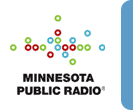 |





 |
Have ideas on how to use the news and other featured content on Sound Learning? What services and features would you like Sound Learning to provide?
Tell us how you use this site, what you like and dislike about it, what else you'd like to see here-anything. Help us help you.
Send us your comments or ideas for using and improving Sound Learning.
Sign up for our
monthly newsletter (September–May) >>
|

|  |

Student Exercises
- Students select daily news clips to listen to and then summarize. Students then can read more about the story in a local or national paper, in print or online. This can be a great activity to begin the day, advisory, or class period, particularly with a class of struggling readers who would benefit from the contextual and auditory overview of news stories before they read them. Whenever possible, pair audio and text versions of the stories for learners.
- Students compare and contrast the MPR audio and text news reports with similar stories in print, online, and television sources, looking for different perspectives and critiquing the benefits of each media type.
- After listening to and analyzing the structure of radio news stories, students create their own radio/audio reports. Selecting a story from a local print source, student summarize the key points, create a short script, rehearse their delivery, record their audio report (either digitally or with a tape recorder), and play the report back to the class. Create a collection of these stories to make an audio portfolio.
Tips and Techniques
- Some different ways to use the news sites: 1.) Students browse the main MPR News site, or the main pages of the various program pages current week's news; 2.) Students read and listen to stories selected and previewed by the teacher; 3.) Students conduct searches for stories on interest or research topics.
- Go to the main MPR News site as a starting point for all the news program sites.
- When there are both audio and text versions of a report, provide students with a print copy to read and take notes on as they listen to the audio.
- Remember to have students cite sources for information or quotations they use in reports, multimedia documents, or other educational projects, including photos and audio clips. Students should include the following information in their citation: document title or description, date of publication or when they found it on the Web, an address (URL), and, if possible, the author, photographer, or artist.
|  |

